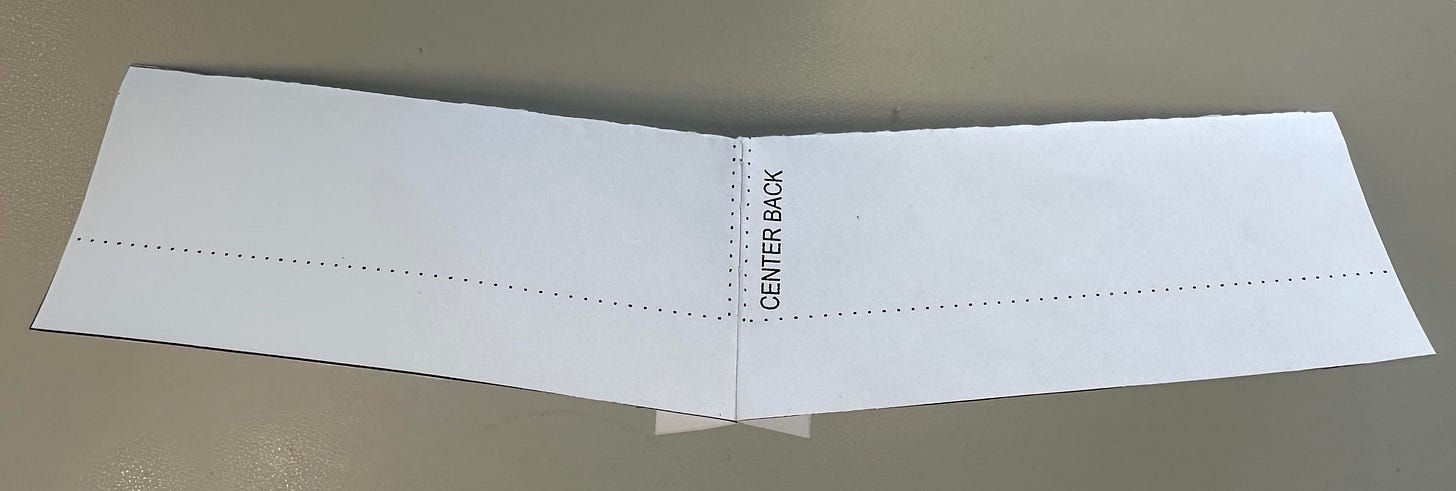Are you “Team Straight Waistband” or “Team Curved Waistband”? People in sewing can have very fixed opinions about one or the other. “Oh I always substitute a xxx waistband for whatever is in the pattern”. Viewing the process of fitting as a dialog between design and body, the waistband is one place where the requirements of the body dominate. You know your own body and nobody can or should tell you what is best for your body.
On the other hand, waistlines for pants can be anywhere on the torso. A narrow straight waistband on a pant with darts is very similar to a contoured waistband of a pant without darts. Why confine ourselves to the binary?
Every torso has many potential waistlines
A waistband is like a slice of a corset, every torso has many potential waistlines.
I have witnessed people claim “a contoured waistband is the best for fat bodies” and then discovered that fat bodies can also fit and wear straight waistbands just fine. In fact, depending on construction, a garment will adapt somewhat with wear. The heat and moisture of the human body will work with the garment so that even a straight waistband will end up somewhat contoured after a lot of wear, like a leather belt.
When you are starting out in pants fitting I recommend a one piece straight folded waistband as we have on the #OLOlivePants. It is hands down the most economical of fabric and by far the easiest to construct and fit.
Examples from Fashion
Fashion is so endlessly creative. Here are a couple of waistbands that combine the strength of being cut on straight grain with features of contoured waistbands.
V2004
First up V2004, a sleek Calvin Klein classic.
The waist band is cut in two straight grain pieces which meet at center back. Check out the pattern piece for the waistband:
See that very slight angle at center back? Subtle but powerful. Try it out on a paper model:
S6137
Second fashion example is this vintage Simplicity S6137.
It contains a pattern piece for what the instructions term an “inside belt” which I think we would now call a facing.
This waistband equivalent is cut on straight grain but at regular positions, 8 in total, the maker is supposed to sew a tiny dart.
The strength of straight grain with the shape of a curve (that could be an advertising slogan!). Labor intensive but effective.
To Swirl
“Swirling” is one of my favorite sewing terms. It refers to the use of heat and steam from an iron to stretch out a ribbon into a curved shape. This is the ‘ironwork’ of tailoring. It can be used to cut a waistband on the straight and give it a curve prior to construction.
Conclusion
The variation in waistband options is truly worthy of its own book. It’s up to you whether you want to try out different styles, sometimes you may not be in the mood to experiment and you stick with a TNT1. All I’m suggesting is that it does not have to be an “either/or”. Fashion offers many options, and all bodies can wear all designs. You can play on both teams. No single way is the “right way”, or the “wrong way”. Each approach has its advantages and disadvantages. There’s a contoured waistband for every body and a straight waistband for every body. Making allows you try this out in combination with different styles of trousers and pants. You get to figure out what you like on your body regardless of whether it was available in shops and in your size.
TNT Tried aNd True












Gee I felt I cheated when I made a dart in the center back of a pants waistband. Well, it used to feel like cheating. Now, none of my adjustments are cheats - just clever solutions to a 3D puzzle.
I find that I need a contoured waistband when it's lower on my body, and straight can work when it's higher. Some of your examples are very interesting - will look at them more closely!